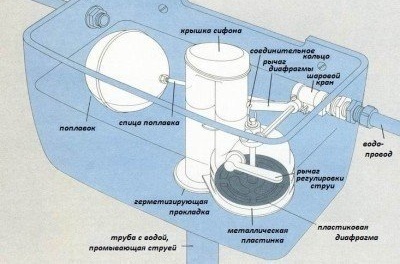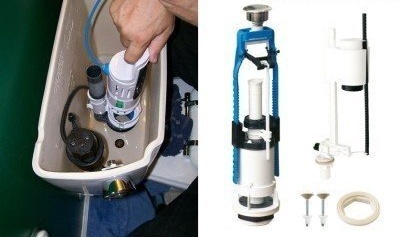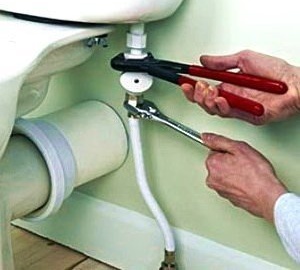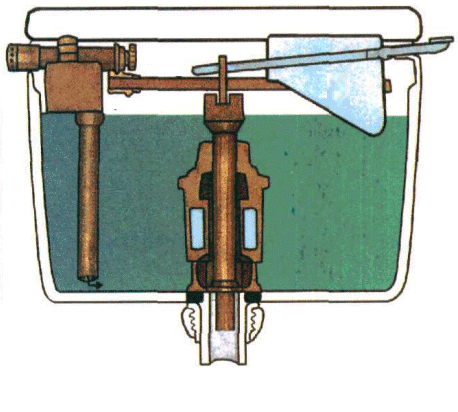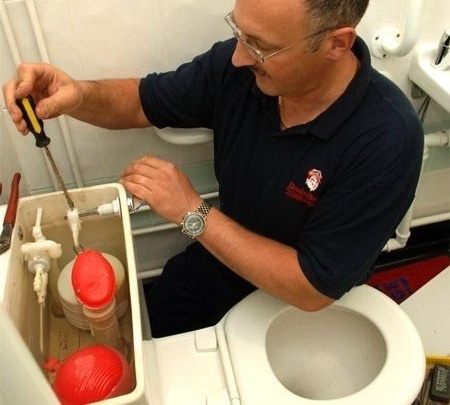Fittings for the toilet flush tank: installation example + adjustment technology
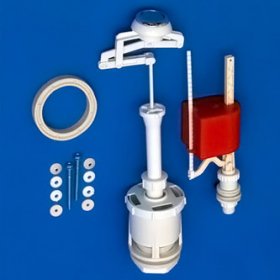
Choosing a toilet, we often evaluate it from an aesthetic point of view, forgetting that there are other important points. One of them is the mechanism of the drain tank, which we only remember when there is noise or a water leak. It is worth remembering that the drain fitting toilet bowl for all its simplicity, a pretty delicate thing. It requires a careful attitude, and sometimes, in case of problems, increased attention. Remember that timely adjustment of the toilet fittings can save your neighbors from the flood, and you from inevitable financial costs.
The device and components of the toilet bowl compact
The most popular floor-mounted compact toilets, the flush cistern of which is mounted on the shelf of the bowl. They are chosen for two reasons: inexpensive price and ease of maintenance.
Despite external differences and some technical nuances, toilets consist of the following structural parts:
-
- Cistern. The water supply can be bottom or side. Tanks with side supply have two openings, one of them is closed with a plug. An upper button is provided for draining water, but some toilets are equipped with a side lever. The standard volume is about 8-10 liters.
- Gulf water system. In other words, it is a stop valve for the toilet. It performs two functions: when empty, it passes water, while when filled, it blocks access to water. Particular attention should be paid to the shut-off valve. Piston valves are becoming less common, the most common are membrane valves.
- Water drainage system. Another name is flush fittings for the toilet. When the button is pressed, it opens the drain hole, after emptying the tank it closes it, and in the event of a breakdown of the water fittings, it provides emergency drainage. The average service life is 10-12 years.
Bowl. The main difference between the bowls is the arrangement of the sewer outlet - direct or oblique. The tank is attached to the bowl shelf with bolts; a rubber gasket is used for tightness between it and the bowl.

The location and principle of operation of the fittings in the tank with the side lever are the same as for the model with the top button
Our next article contains detailed instructions for repairing the toilet flush tank:https://aquatech.tomathouse.com/en/santehnika/unitaz-rakovina/remont-slivnogo-bachka-unitaza.html.
Technology for installing drain equipment
There are three things to do:
- install the drain tank on the toilet shelf;
- connect it to the water supply;
- adjust fittings.
Initially, a rubber gasket is fixed to the shelf. Many products are self-adhesive for a snug fit. The tank is fixed with special bolts with rubber cone-shaped gaskets placed inside the tank, with sharp ends in the holes.
The cone shape of the gaskets protects the container from leaking. Bolts are placed in the holes, the nuts are tightened - the tank is installed.
Attention! Tighten fasteners with extreme caution so as not to overtighten the bolts. Pottery can crack, which means you have to buy a new toilet bowl or flush tank.
The next step is to connect a cold water hose. A washer gasket is required, otherwise the connection will leak. To check let water. If all the connections are dry, it means that the tank is installed correctly, and the toilet bowl is ready for use.
You will find a more detailed installation guide for the drain tank in our next article:https://aquatech.tomathouse.com/en/santehnika/unitaz-rakovina/ustanovka-i-kreplenie-bachka-k-unitazu.html.
Possible malfunctions and their correction
Sometimes intervention is required in the operation of the drain tank due to a forced repair or for practical reasons. Consider the most common situations when you need to adjust the toilet fittings.
- Reduce flush volume. The reason is water saving, with the current increase in utility prices, this issue is becoming relevant. The fittings should be adjusted so that the amount of water in the tank decreases. If the lever is made of brass, it needs to be bent a little. The position of the float will tell you the required degree of bending. Modern valves are often made of plastic. In this case, you need to adjust the fixing screw or locking ratchet.
- We eliminate the leakage of the tank. If murmur is constantly heard, and water enters through the overflow, you should do the same as when reducing the volume of flushing. But another reason is also possible - pear wear. This situation is even worse, since water flows constantly, even with a half-empty tank. To solve the problem, it is necessary to “weight” the pear by tying several nuts, a piece of lead or a cast-iron coupling to it. You can change the pear to a new one. For this, the old product should be taken with you to the store as a sample, since the spillway fittings for toilets can vary in shape and size.
- We eliminate a weak drain. If the toilet does not flush well, while the water level in the tank does not matter, most likely something has got into the toilet drain or the outlet of the tank. Sometimes this item is a slipping rubber hose that makes the water flow soundless. It gets stuck at the level of the toilet bowl and interferes with flushing. If the family has children, you can find anything in the tank. The problem can be easily solved if the object is immediately under the pear - you can get it with your hand or tweezers. If it has sunk deeper, you will have to remove the tank.
- We replace the large gasket. Leaking under the tank is a sign of a worn gasket between the toilet and the tank. It is necessary to remove the tank, remove the old gasket, fix a new one. The rust that appears during leakage should be removed with a wire brush.
Sometimes, a drastic repair is not required to adjust the valves. Misalignment of the float or shutoff valve can also cause leakage. That is why it is important to carefully remove the cover and check all parts of the valve before starting work. Sometimes for drain mechanism repair just replace a small part, bolts or gaskets.
